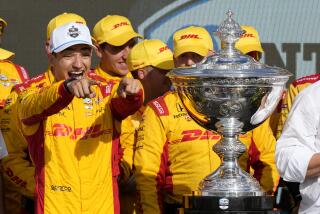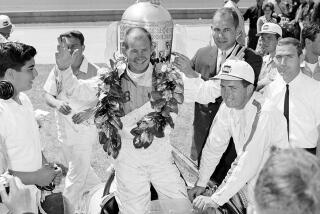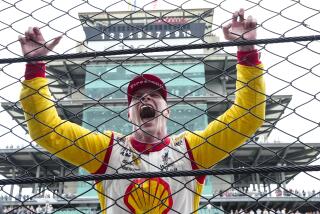WHO’S IN SECOND? : Yellow Flags, Pit Stops Turn Indy 500 Scoring Into Comedy of Errors; Fittipaldi Named Runner-up
- Share via
INDIANAPOLIS — According to one race track adage, nobody cares who finished second.
So much for adages.
When the difference between second and third figures to be about $100,000, people care. And when the difference between second and seventh figures to be about $300,000, as it was a year ago, people care a lot. And besides, racers do have their pride.
For the longest while after Sunday’s Indianapolis 500, second place was the hot topic. In what seemed a fitting addendum to an unsatisfying race with an unsatisfactory yellow-flag finish, nobody knew who had finished second.
Was it Scotsman Jim Crawford from nearby Noblesville, Ind., who followed winner Rick Mears across the finish line and was hailed as the runner-up? He even sat through a press conference, thinking all the while that he had finished second.
Was it Al Unser Sr., last year’s winner? He was listed behind teammate Mears in the unofficial standings, both the preliminary and the revised. Official standings are not announced until 8 o’clock the morning after the race.
Or was it Emerson Fittipaldi, the Brazilian from Miami, the former two-time Formula One champion who, after early-race difficulties, came back strong, only to be penalized for passing during a caution period? That dropped him to seventh place.
Fittipaldi and his crew, with supporting testimony from driver Rich Vogler, said that the two-lap penalty was an unjust one.
In the end, slightly more than three hours after race’s end, Fittipaldi prevailed. His penalty was rescinded, he was moved back up the unofficial list from seventh to second, seven seconds behind Mears, and Unser was dropped to third.
Crawford, the unfortunate victim of a miscalculation, and possibly the most confused person involved, wound up sixth.
How did all of this happen?
Yellow flags.
Yellow flags not only spoil the racing, they also produce pit stops in the extreme. And when there are pit stops in the extreme, the scoring gets complicated. For much of Sunday’s race, not very many people were terribly sure just where anybody was running. Entire laps were gained and lost in the wink of an eye.
That’s how Crawford apparently got caught. It was explained that he was simply credited with a lap more than he had run. Unfortunately for him, he didn’t learn that until after he had been set before reporters as the second-place finisher, when the Fittipaldi controversy was just brewing.
And then later, because he had been given a piece of misinformation, he thought that he had been penalized a lap.
Puzzled, he said: “I was extra careful not to pass under the yellow flag so I don’t see why I should be penalized for something other people did.”
By the time his situation was resolved, he no longer was around for comment.
The Fittipaldi business was considerably more complicated, or at least was made to appear that way.
Fittipaldi drove on despite two flat tires, a broken front wing and resulting handling difficulties in the early going. “By the fourth pit stop, we had made enough adjustments that the balance and the handling were really good,” he said. “We were the fastest car over the last 200 miles. . . . On the track, I was second place. I did nothing illegal.”
Maybe not the fastest, considering Mears’ low flying, but certainly one of the fastest.
On the 166th lap, however, just after a yellow-flag, 6-second fuel stop that got him back on the lead lap with Mears, it was announced that Fittipaldi had been penalized two laps for passing Vogler during the caution period.
When that intelligence was relayed to Fittipaldi by his crew on the radio, he explained that it was quite the other way around, that Vogler had passed him, then, apparently realizing what he had done, had waved Fittipaldi around him, to his proper spot in the lineup.
According to Moe Nunn, the Fittipaldi team’s chief engineer, that information was passed on to the sanctioning United States Auto Club.
“They said they’d give us back the lap and restore our position,” Nunn said. “Then with just a few laps left, they came back and told us we had been observed passing under the yellow and the penalty would be two laps.”
Fittipaldi said that he took that news with equanimity. “I wanted to bite the steering wheel,” he said.
Until the situation was resolved, he would not talk with reporters. He and Vogler told their stories to USAC, then he returned to his garage, breaking off short conversations with friends, team members and visitors to pace, sit, then pace some more.
To one crewman, who was hearing the story for at least the fourth time, he said: “Vogler’s the guy who passed me. And then I passed him. I came out (of the pits) and he went, whoosh! by me. Then he wave me around on the back straight.”
To skier Billy Kidd, a garage guest, he said: “You know how it is when you come in a situation like that. The adrenaline is running so high, if somebody says two words, boom!”
A sympathetic Kidd said he could understand the frustration and recalled the time that he had been deprived of a spot on the U.S. national ski team when he was accused of missing a gate, despite testimony by other skiers that he had skied it cleanly.
Car owner Pat Patrick said that if the penalty stood overnight, he would surely protest it. He had a lawyer, Forrest Bowman, draw up the team’s official explanation.
Generally, though, he kept a low profile. Patrick and Roger Penske were the leaders of the revolution against USAC that led to the establishment of the rival Championship Auto Racing Teams a decade ago and apparently Patrick didn’t want to invite more trouble than existed.
Still, he couldn’t hold everything in. “For USAC to do that was just plain inept on their part,” he said of the penalty, while it still was a penalty.
Vogler dropped in, offering hope, condolences and suggesting that the track observers at this particular race were probably the same ones who had been here for the inaugural 500 in 1911.
Vogler’s explanation to newspapermen matched the Fittipaldi crew’s.
“He didn’t pass me on the yellow,” Vogler said. “The blend spot (for traffic exiting the pits) is the inside guard rail in Turn 1 and at that point Emerson was ahead of me. I passed him and when we got to the back straightaway, I waved him by.”
When finally it was announced that the penalty had been rescinded--Fittipaldi’s public relations people beat USAC to the punch by two minutes on that--Fittipaldi paid a triumphant visit to the press room.
“With all of the race experience I have, it would be very stupid to myself to pass a car on a yellow situation,” Fittipaldi said. “I am racing now 21 years . . . It was very, how you say, sporting for (Vogler) to go and tell exactly what happened.”
And so, the great second-place controversy of 1988 passed quietly into history.
Until at least this morning at 8 o’clock.
More to Read
Go beyond the scoreboard
Get the latest on L.A.'s teams in the daily Sports Report newsletter.
You may occasionally receive promotional content from the Los Angeles Times.










